Corporate Reporting: Analysis of AGL Energy's Accounting Practices
VerifiedAdded on 2021/02/21
|6
|1347
|298
Report
AI Summary
This report provides an analysis of AGL Energy Ltd's corporate accounting practices. It begins with a background of the company, its industry, and its CEO. The scope of the study focuses on the importance of advanced corporate accounting plans for business success, emphasizing profitability and productivity. The report then delves into the accounting treatment, highlighting the purpose of financial statements and their use by stakeholders. It examines AASB accounting standards relevant to AGL Energy, such as AASB 1023 and AASB 7, emphasizing compliance and the importance of disclosures. Furthermore, the report discusses the differences between fixed and flexible formats of assets and liabilities in the balance sheet, their applications, and the standards followed by AGL Energy. References to relevant books and journals are also provided to support the analysis. This report highlights the importance of proper accounting practices for a publicly listed company.
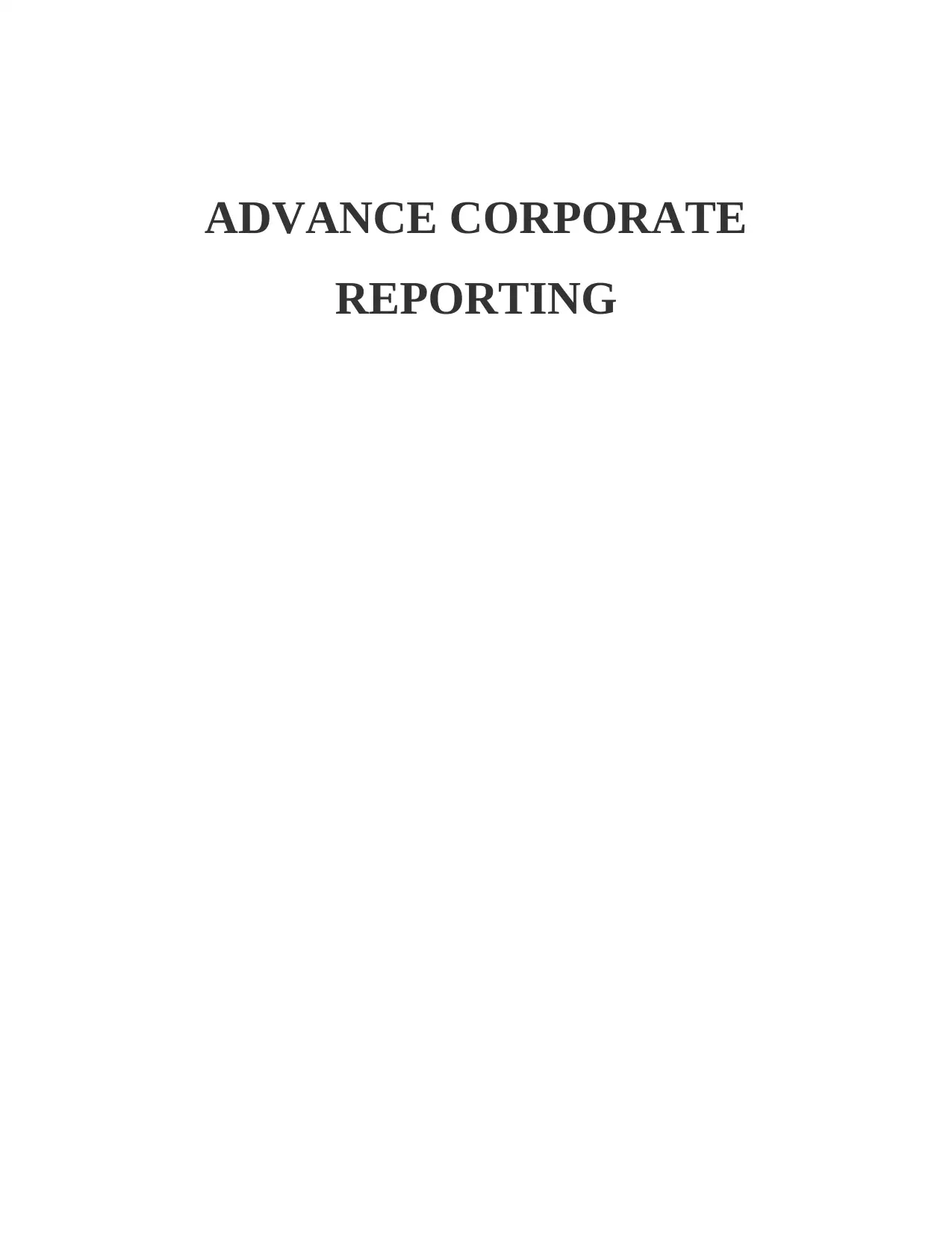
ADVANCE CORPORATE
REPORTING
REPORTING
Paraphrase This Document
Need a fresh take? Get an instant paraphrase of this document with our AI Paraphraser
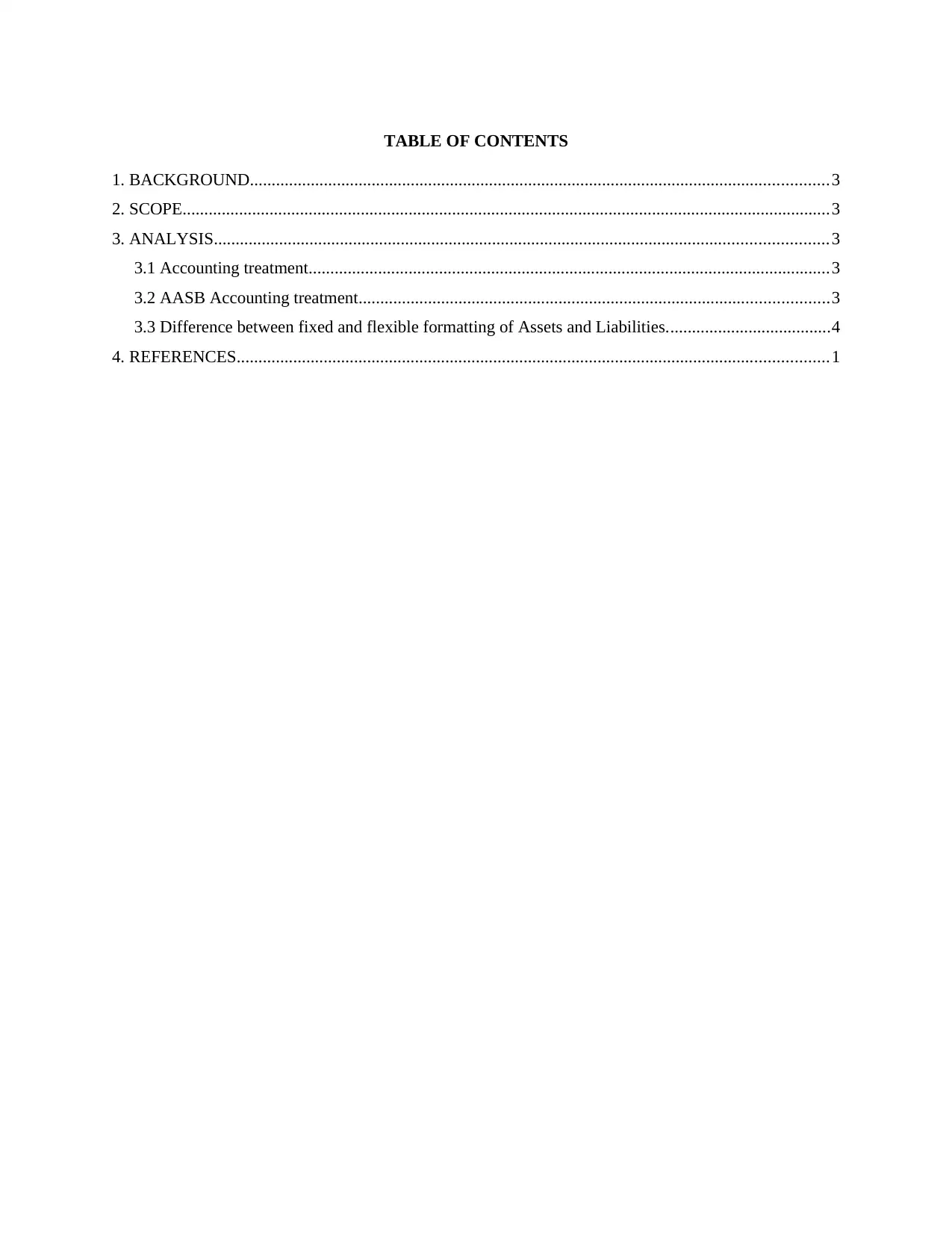
TABLE OF CONTENTS
1. BACKGROUND.....................................................................................................................................3
2. SCOPE.....................................................................................................................................................3
3. ANALYSIS.............................................................................................................................................3
3.1 Accounting treatment........................................................................................................................3
3.2 AASB Accounting treatment............................................................................................................3
3.3 Difference between fixed and flexible formatting of Assets and Liabilities......................................4
4. REFERENCES........................................................................................................................................1
1. BACKGROUND.....................................................................................................................................3
2. SCOPE.....................................................................................................................................................3
3. ANALYSIS.............................................................................................................................................3
3.1 Accounting treatment........................................................................................................................3
3.2 AASB Accounting treatment............................................................................................................3
3.3 Difference between fixed and flexible formatting of Assets and Liabilities......................................4
4. REFERENCES........................................................................................................................................1
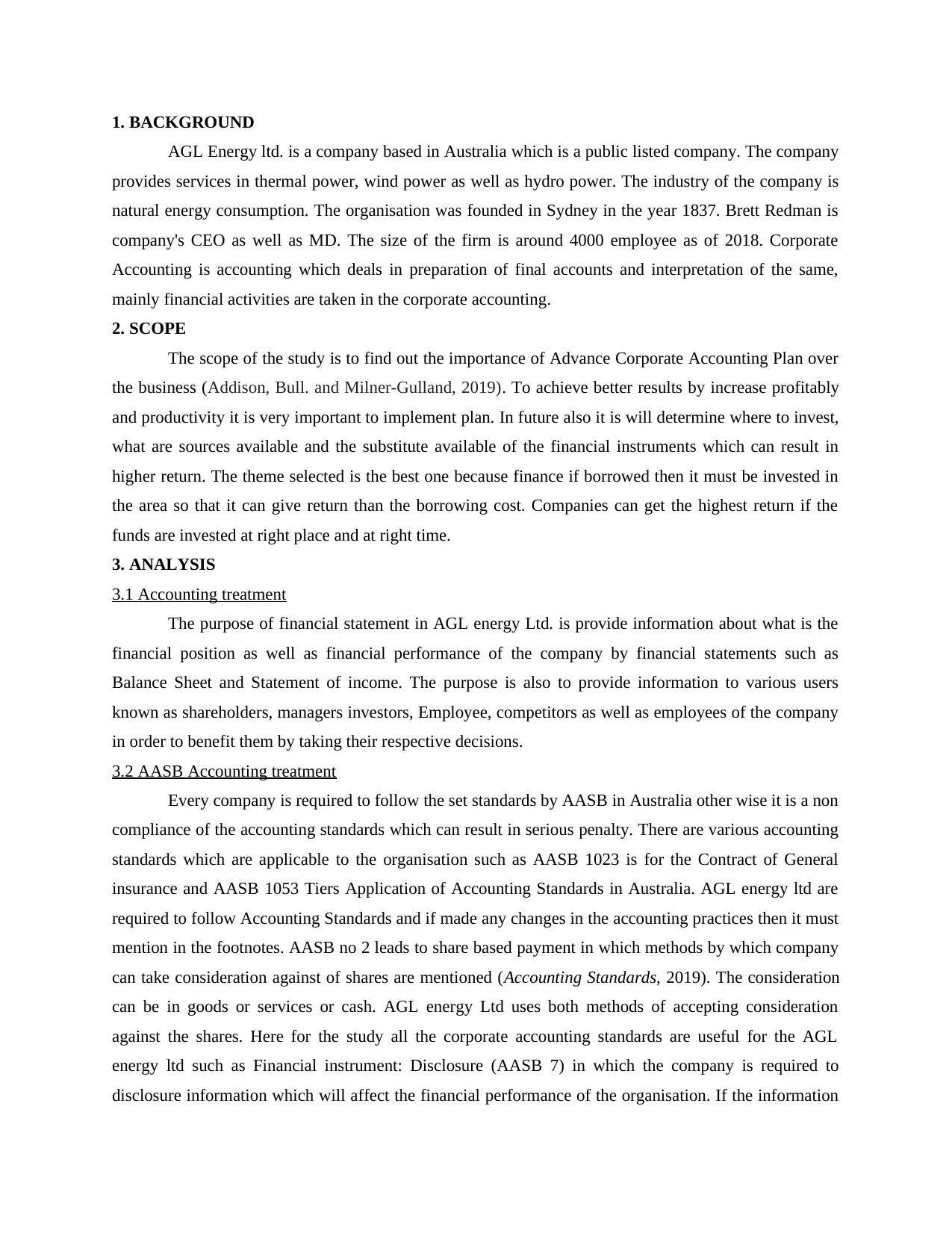
1. BACKGROUND
AGL Energy ltd. is a company based in Australia which is a public listed company. The company
provides services in thermal power, wind power as well as hydro power. The industry of the company is
natural energy consumption. The organisation was founded in Sydney in the year 1837. Brett Redman is
company's CEO as well as MD. The size of the firm is around 4000 employee as of 2018. Corporate
Accounting is accounting which deals in preparation of final accounts and interpretation of the same,
mainly financial activities are taken in the corporate accounting.
2. SCOPE
The scope of the study is to find out the importance of Advance Corporate Accounting Plan over
the business (Addison, Bull. and Milner‐Gulland, 2019). To achieve better results by increase profitably
and productivity it is very important to implement plan. In future also it is will determine where to invest,
what are sources available and the substitute available of the financial instruments which can result in
higher return. The theme selected is the best one because finance if borrowed then it must be invested in
the area so that it can give return than the borrowing cost. Companies can get the highest return if the
funds are invested at right place and at right time.
3. ANALYSIS
3.1 Accounting treatment
The purpose of financial statement in AGL energy Ltd. is provide information about what is the
financial position as well as financial performance of the company by financial statements such as
Balance Sheet and Statement of income. The purpose is also to provide information to various users
known as shareholders, managers investors, Employee, competitors as well as employees of the company
in order to benefit them by taking their respective decisions.
3.2 AASB Accounting treatment
Every company is required to follow the set standards by AASB in Australia other wise it is a non
compliance of the accounting standards which can result in serious penalty. There are various accounting
standards which are applicable to the organisation such as AASB 1023 is for the Contract of General
insurance and AASB 1053 Tiers Application of Accounting Standards in Australia. AGL energy ltd are
required to follow Accounting Standards and if made any changes in the accounting practices then it must
mention in the footnotes. AASB no 2 leads to share based payment in which methods by which company
can take consideration against of shares are mentioned (Accounting Standards, 2019). The consideration
can be in goods or services or cash. AGL energy Ltd uses both methods of accepting consideration
against the shares. Here for the study all the corporate accounting standards are useful for the AGL
energy ltd such as Financial instrument: Disclosure (AASB 7) in which the company is required to
disclosure information which will affect the financial performance of the organisation. If the information
AGL Energy ltd. is a company based in Australia which is a public listed company. The company
provides services in thermal power, wind power as well as hydro power. The industry of the company is
natural energy consumption. The organisation was founded in Sydney in the year 1837. Brett Redman is
company's CEO as well as MD. The size of the firm is around 4000 employee as of 2018. Corporate
Accounting is accounting which deals in preparation of final accounts and interpretation of the same,
mainly financial activities are taken in the corporate accounting.
2. SCOPE
The scope of the study is to find out the importance of Advance Corporate Accounting Plan over
the business (Addison, Bull. and Milner‐Gulland, 2019). To achieve better results by increase profitably
and productivity it is very important to implement plan. In future also it is will determine where to invest,
what are sources available and the substitute available of the financial instruments which can result in
higher return. The theme selected is the best one because finance if borrowed then it must be invested in
the area so that it can give return than the borrowing cost. Companies can get the highest return if the
funds are invested at right place and at right time.
3. ANALYSIS
3.1 Accounting treatment
The purpose of financial statement in AGL energy Ltd. is provide information about what is the
financial position as well as financial performance of the company by financial statements such as
Balance Sheet and Statement of income. The purpose is also to provide information to various users
known as shareholders, managers investors, Employee, competitors as well as employees of the company
in order to benefit them by taking their respective decisions.
3.2 AASB Accounting treatment
Every company is required to follow the set standards by AASB in Australia other wise it is a non
compliance of the accounting standards which can result in serious penalty. There are various accounting
standards which are applicable to the organisation such as AASB 1023 is for the Contract of General
insurance and AASB 1053 Tiers Application of Accounting Standards in Australia. AGL energy ltd are
required to follow Accounting Standards and if made any changes in the accounting practices then it must
mention in the footnotes. AASB no 2 leads to share based payment in which methods by which company
can take consideration against of shares are mentioned (Accounting Standards, 2019). The consideration
can be in goods or services or cash. AGL energy Ltd uses both methods of accepting consideration
against the shares. Here for the study all the corporate accounting standards are useful for the AGL
energy ltd such as Financial instrument: Disclosure (AASB 7) in which the company is required to
disclosure information which will affect the financial performance of the organisation. If the information
⊘ This is a preview!⊘
Do you want full access?
Subscribe today to unlock all pages.

Trusted by 1+ million students worldwide
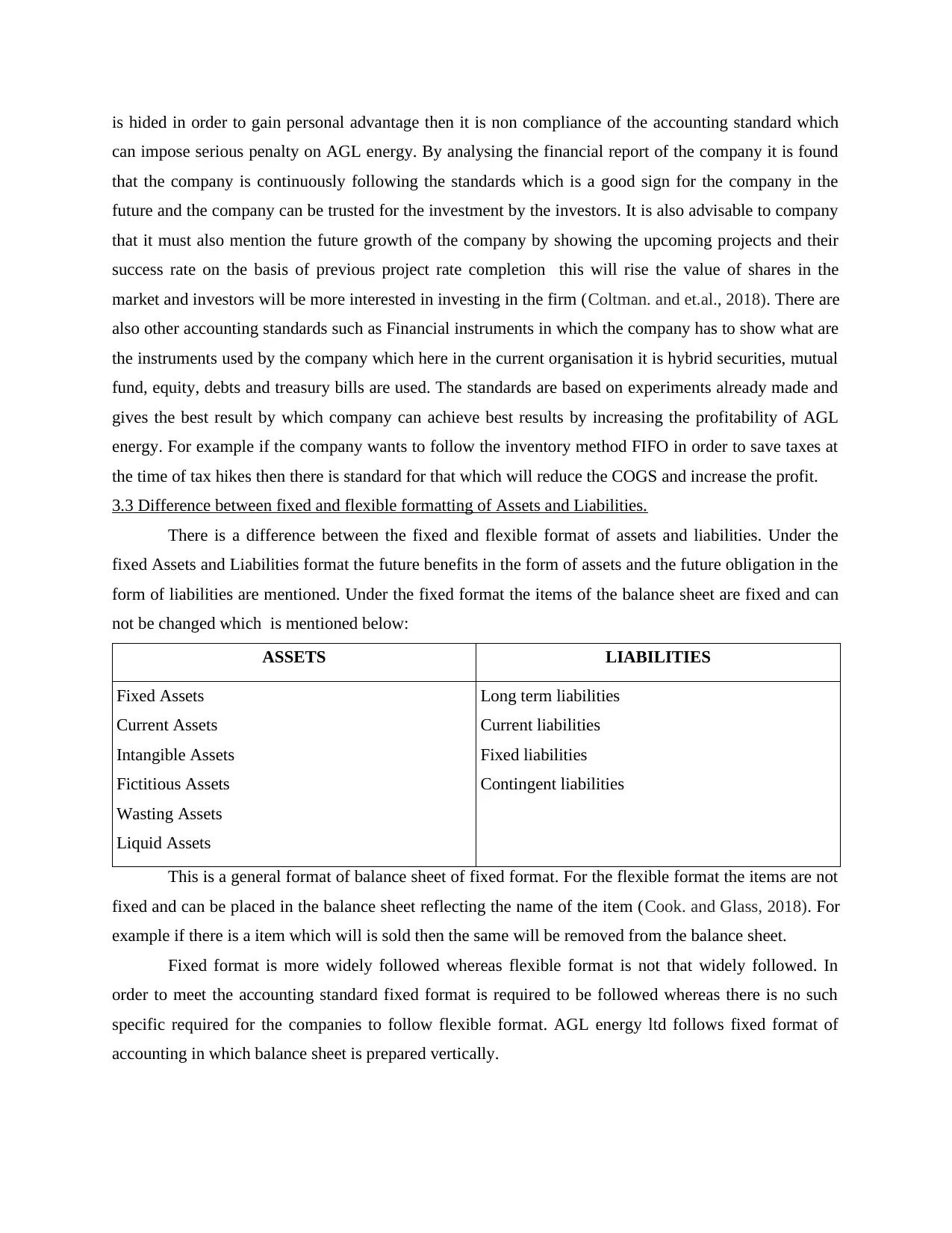
is hided in order to gain personal advantage then it is non compliance of the accounting standard which
can impose serious penalty on AGL energy. By analysing the financial report of the company it is found
that the company is continuously following the standards which is a good sign for the company in the
future and the company can be trusted for the investment by the investors. It is also advisable to company
that it must also mention the future growth of the company by showing the upcoming projects and their
success rate on the basis of previous project rate completion this will rise the value of shares in the
market and investors will be more interested in investing in the firm (Coltman. and et.al., 2018). There are
also other accounting standards such as Financial instruments in which the company has to show what are
the instruments used by the company which here in the current organisation it is hybrid securities, mutual
fund, equity, debts and treasury bills are used. The standards are based on experiments already made and
gives the best result by which company can achieve best results by increasing the profitability of AGL
energy. For example if the company wants to follow the inventory method FIFO in order to save taxes at
the time of tax hikes then there is standard for that which will reduce the COGS and increase the profit.
3.3 Difference between fixed and flexible formatting of Assets and Liabilities.
There is a difference between the fixed and flexible format of assets and liabilities. Under the
fixed Assets and Liabilities format the future benefits in the form of assets and the future obligation in the
form of liabilities are mentioned. Under the fixed format the items of the balance sheet are fixed and can
not be changed which is mentioned below:
ASSETS LIABILITIES
Fixed Assets
Current Assets
Intangible Assets
Fictitious Assets
Wasting Assets
Liquid Assets
Long term liabilities
Current liabilities
Fixed liabilities
Contingent liabilities
This is a general format of balance sheet of fixed format. For the flexible format the items are not
fixed and can be placed in the balance sheet reflecting the name of the item (Cook. and Glass, 2018). For
example if there is a item which will is sold then the same will be removed from the balance sheet.
Fixed format is more widely followed whereas flexible format is not that widely followed. In
order to meet the accounting standard fixed format is required to be followed whereas there is no such
specific required for the companies to follow flexible format. AGL energy ltd follows fixed format of
accounting in which balance sheet is prepared vertically.
can impose serious penalty on AGL energy. By analysing the financial report of the company it is found
that the company is continuously following the standards which is a good sign for the company in the
future and the company can be trusted for the investment by the investors. It is also advisable to company
that it must also mention the future growth of the company by showing the upcoming projects and their
success rate on the basis of previous project rate completion this will rise the value of shares in the
market and investors will be more interested in investing in the firm (Coltman. and et.al., 2018). There are
also other accounting standards such as Financial instruments in which the company has to show what are
the instruments used by the company which here in the current organisation it is hybrid securities, mutual
fund, equity, debts and treasury bills are used. The standards are based on experiments already made and
gives the best result by which company can achieve best results by increasing the profitability of AGL
energy. For example if the company wants to follow the inventory method FIFO in order to save taxes at
the time of tax hikes then there is standard for that which will reduce the COGS and increase the profit.
3.3 Difference between fixed and flexible formatting of Assets and Liabilities.
There is a difference between the fixed and flexible format of assets and liabilities. Under the
fixed Assets and Liabilities format the future benefits in the form of assets and the future obligation in the
form of liabilities are mentioned. Under the fixed format the items of the balance sheet are fixed and can
not be changed which is mentioned below:
ASSETS LIABILITIES
Fixed Assets
Current Assets
Intangible Assets
Fictitious Assets
Wasting Assets
Liquid Assets
Long term liabilities
Current liabilities
Fixed liabilities
Contingent liabilities
This is a general format of balance sheet of fixed format. For the flexible format the items are not
fixed and can be placed in the balance sheet reflecting the name of the item (Cook. and Glass, 2018). For
example if there is a item which will is sold then the same will be removed from the balance sheet.
Fixed format is more widely followed whereas flexible format is not that widely followed. In
order to meet the accounting standard fixed format is required to be followed whereas there is no such
specific required for the companies to follow flexible format. AGL energy ltd follows fixed format of
accounting in which balance sheet is prepared vertically.
Paraphrase This Document
Need a fresh take? Get an instant paraphrase of this document with our AI Paraphraser
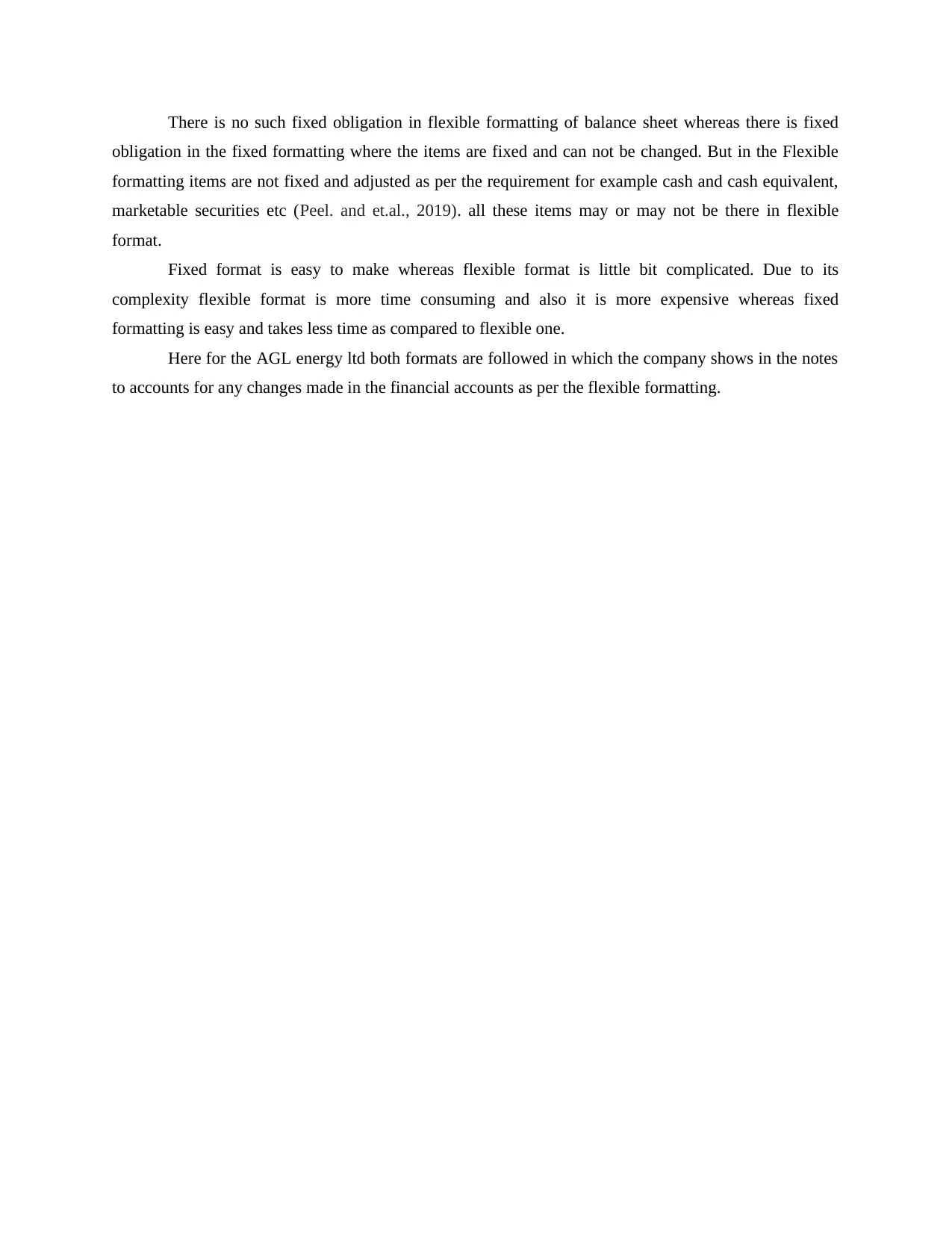
There is no such fixed obligation in flexible formatting of balance sheet whereas there is fixed
obligation in the fixed formatting where the items are fixed and can not be changed. But in the Flexible
formatting items are not fixed and adjusted as per the requirement for example cash and cash equivalent,
marketable securities etc (Peel. and et.al., 2019). all these items may or may not be there in flexible
format.
Fixed format is easy to make whereas flexible format is little bit complicated. Due to its
complexity flexible format is more time consuming and also it is more expensive whereas fixed
formatting is easy and takes less time as compared to flexible one.
Here for the AGL energy ltd both formats are followed in which the company shows in the notes
to accounts for any changes made in the financial accounts as per the flexible formatting.
obligation in the fixed formatting where the items are fixed and can not be changed. But in the Flexible
formatting items are not fixed and adjusted as per the requirement for example cash and cash equivalent,
marketable securities etc (Peel. and et.al., 2019). all these items may or may not be there in flexible
format.
Fixed format is easy to make whereas flexible format is little bit complicated. Due to its
complexity flexible format is more time consuming and also it is more expensive whereas fixed
formatting is easy and takes less time as compared to flexible one.
Here for the AGL energy ltd both formats are followed in which the company shows in the notes
to accounts for any changes made in the financial accounts as per the flexible formatting.
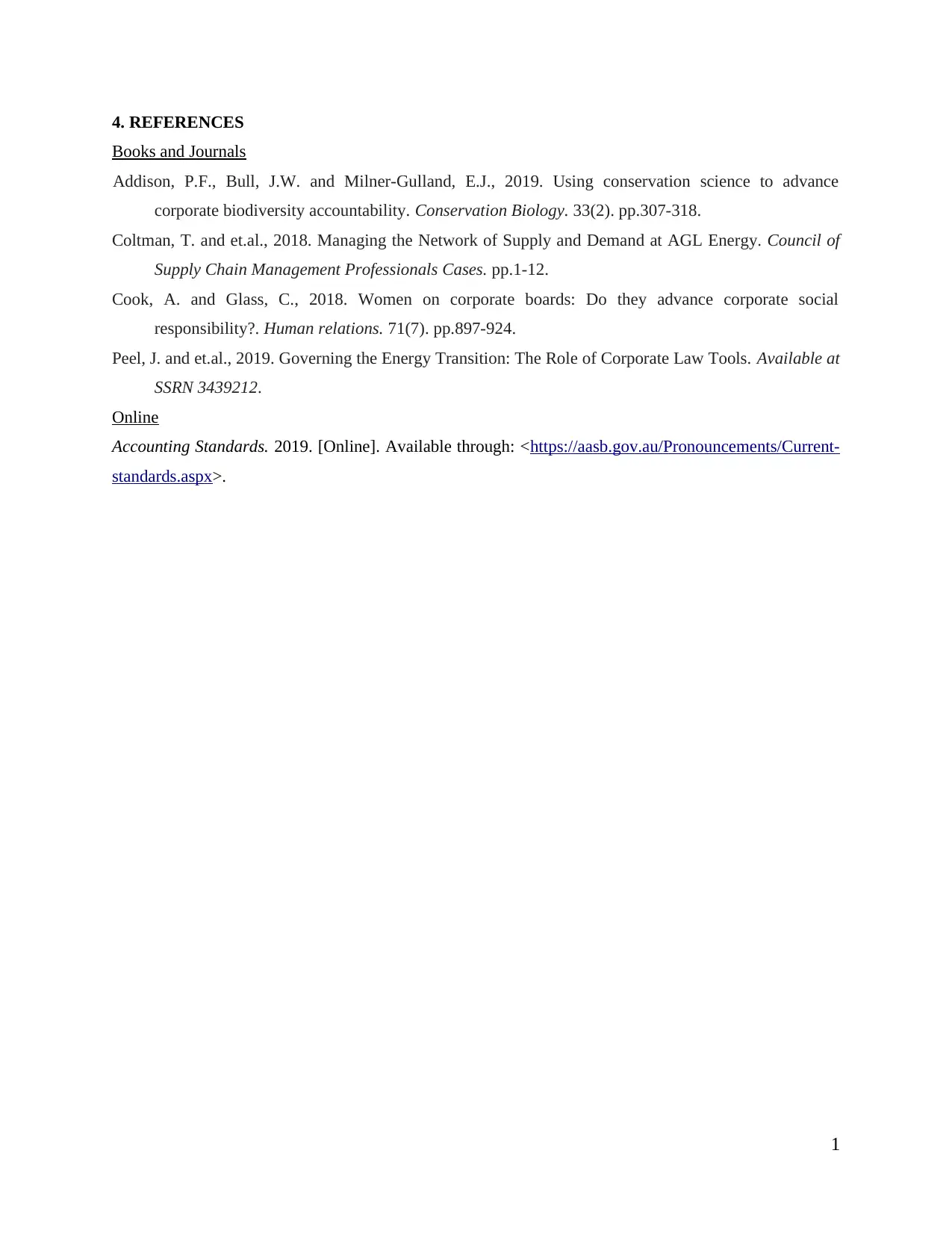
4. REFERENCES
Books and Journals
Addison, P.F., Bull, J.W. and Milner‐Gulland, E.J., 2019. Using conservation science to advance
corporate biodiversity accountability. Conservation Biology. 33(2). pp.307-318.
Coltman, T. and et.al., 2018. Managing the Network of Supply and Demand at AGL Energy. Council of
Supply Chain Management Professionals Cases. pp.1-12.
Cook, A. and Glass, C., 2018. Women on corporate boards: Do they advance corporate social
responsibility?. Human relations. 71(7). pp.897-924.
Peel, J. and et.al., 2019. Governing the Energy Transition: The Role of Corporate Law Tools. Available at
SSRN 3439212.
Online
Accounting Standards. 2019. [Online]. Available through: <https://aasb.gov.au/Pronouncements/Current-
standards.aspx>.
1
Books and Journals
Addison, P.F., Bull, J.W. and Milner‐Gulland, E.J., 2019. Using conservation science to advance
corporate biodiversity accountability. Conservation Biology. 33(2). pp.307-318.
Coltman, T. and et.al., 2018. Managing the Network of Supply and Demand at AGL Energy. Council of
Supply Chain Management Professionals Cases. pp.1-12.
Cook, A. and Glass, C., 2018. Women on corporate boards: Do they advance corporate social
responsibility?. Human relations. 71(7). pp.897-924.
Peel, J. and et.al., 2019. Governing the Energy Transition: The Role of Corporate Law Tools. Available at
SSRN 3439212.
Online
Accounting Standards. 2019. [Online]. Available through: <https://aasb.gov.au/Pronouncements/Current-
standards.aspx>.
1
⊘ This is a preview!⊘
Do you want full access?
Subscribe today to unlock all pages.

Trusted by 1+ million students worldwide
1 out of 6
Related Documents
Your All-in-One AI-Powered Toolkit for Academic Success.
+13062052269
info@desklib.com
Available 24*7 on WhatsApp / Email
![[object Object]](/_next/static/media/star-bottom.7253800d.svg)
Unlock your academic potential
Copyright © 2020–2025 A2Z Services. All Rights Reserved. Developed and managed by ZUCOL.



